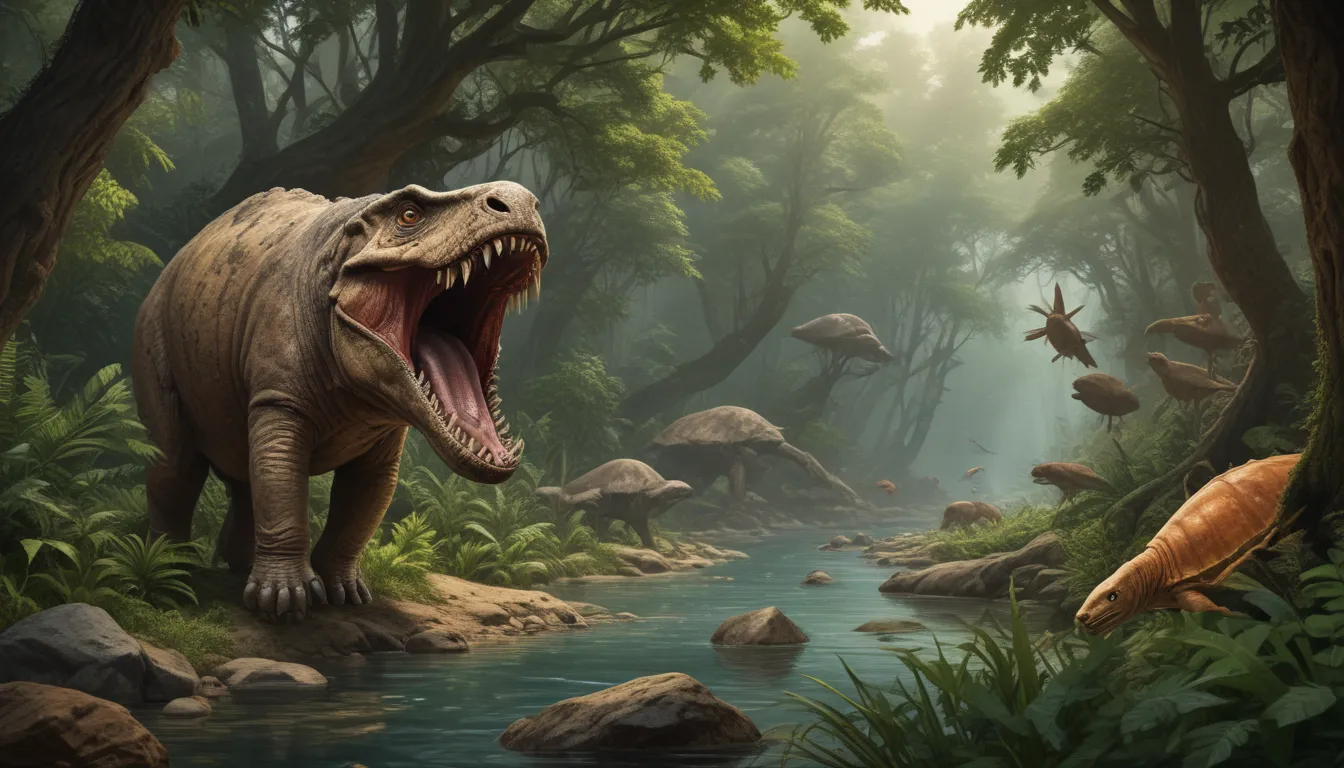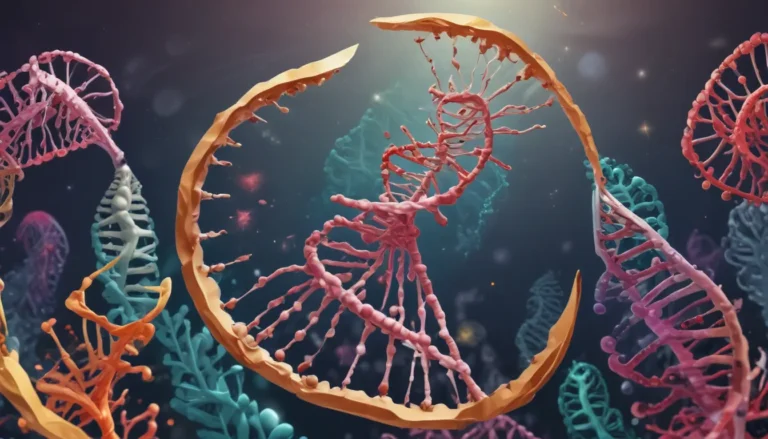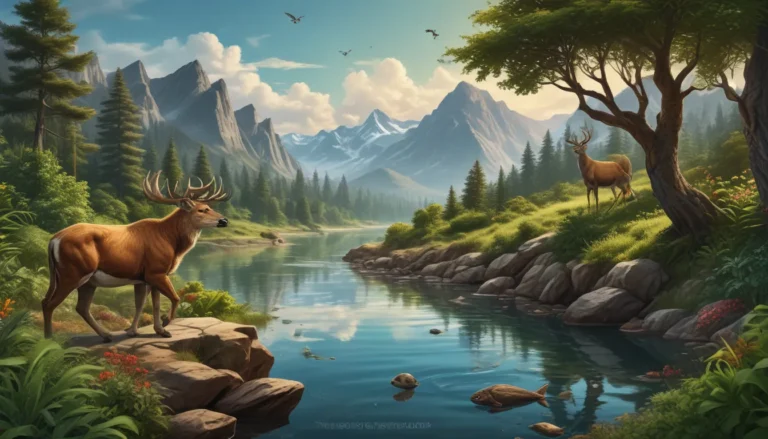A Note About Images: The images used in our articles are for illustration purposes only and may not exactly match the content. They are meant to engage readers, but the text should be relied upon for accurate information.
In the vast tapestry of Earth’s history lies a profound narrative of ancient ecosystems, waiting to be unraveled by the science of paleoecology. This captivating field delves into the depths of time, piecing together the intricate puzzle of our planet’s ecological past. By analyzing fossilized remains, sedimentary layers, and geological evidence, paleoecologists shed light on the evolution of life, climate patterns, and the dynamics of ancient ecosystems. Join us on a journey to explore the astonishing facts that illuminate the resilience and adaptability of Earth’s ecosystems through the ages.
Understanding the Evolution of Life on Earth
The study of paleoecology unveils the captivating story of life’s evolutionary journey. Delving into fossil records and ancient ecosystems, scientists can decipher how species adapted, thrived, or perished over time. By carefully examining plant and animal remains, paleoecologists piece together the puzzle of Earth’s biological past, offering insights into the path of evolution.
Exploring Insights into Climate Change
One of the pivotal roles of paleoecology is providing valuable insights into climate change. Through the analysis of ancient pollen, sediment cores, and isotopic data, scientists reconstruct past climate patterns. This knowledge not only enhances our understanding of natural climate variability but also highlights the impact of human activities on our current climate.
Unveiling Ancient Food Webs and Trophic Interactions
Paleoecology offers a window into the past by unraveling ancient food webs and trophic interactions. By studying predator-prey relationships and species distribution in fossil assemblages, scientists gain a deeper understanding of how ecosystems functioned in bygone eras. This knowledge sheds light on the complexities of ancient ecosystems and how they evolved over time.
The Crucial Role of Paleobotany in Paleoecology
Paleobotany stands as a vital pillar of paleoecology, enabling scientists to reconstruct past vegetation types and understand how plant communities responded to environmental changes. By studying fossilized plants, paleobotanists offer valuable insights into the structure and dynamics of ancient ecosystems, painting a vivid picture of Earth’s botanical heritage.
Unearthing Secrets Through Microfossils
Microfossils, such as foraminifera and diatoms, play a significant role in paleoecology by providing key information about past oceanic and freshwater environments. These microscopic organisms offer insights into ancient water chemistry, salinity, and temperature, unraveling the history of Earth’s aquatic systems and enriching our understanding of ancient environments.
Shedding Light on Causes of Ancient Mass Extinctions
The study of paleoecology serves as a beacon in uncovering the causes of ancient mass extinction events. By delving into the fossil record, scientists can decipher the triggers behind catastrophic events, such as asteroid impacts or volcanic activity. This knowledge aids in understanding the dynamics of extinctions and their implications for future biodiversity loss.
Illuminating Human Evolution Through Paleoenvironmental Reconstructions
Paleoecology not only delves into the realms of ancient ecosystems but also contributes valuable insights into the environmental factors that shaped human evolution. By studying ancient landscapes, climate conditions, and available resources, scientists shed light on the challenges our ancestors faced and the environments they thrived in, enriching our understanding of human evolution.
Unraveling Ancient Diets Through Coprolites
The study of coprolites, fossilized feces, provides a glimpse into the dietary preferences and feeding behaviors of ancient organisms. By analyzing these remnants, paleoecologists reconstruct the menu of long-extinct creatures, unraveling the intricate relationships between species and their ecological roles in ancient ecosystems.
Predicting Future Ecological Changes Through Paleoecology
Drawing upon insights gleaned from studying past ecosystems, paleoecologists can make informed predictions about how modern environments may respond to ongoing environmental changes. This foresight is instrumental in shaping effective conservation strategies aimed at preserving biodiversity and safeguarding the delicate balance of Earth’s ecosystems.
Unveiling Disease Ecology Through Paleontological Insights
The study of paleoecology extends its reach into disease ecology by examining ancient hosts and parasites, reconstructing the history of diseases and their spread over time. This knowledge not only sheds light on past epidemics but also offers valuable lessons for managing present-day health challenges, bridging the gap between the past and present.
Safeguarding Paleontological Sites Through Paleoecology
Paleoecologists play a crucial role in conserving and managing paleontological sites by studying the geological and ecological context of fossil locations. Their work ensures the preservation of these scientific resources for future generations, maintaining the integrity of paleontological sites for continued research and discovery.
Unveiling Mysteries Through Forensic Paleoecology
The realm of paleoecology extends its reach into forensic science, offering insights into ancient crime scenes through the analysis of insect remains. By providing valuable information on the timing of events and the presence of human remains, paleoecologists assist forensic scientists in solving cold cases and reconstructing past crime scenes.
Uncovering the Intricacies of Species Coevolution
Through the lens of paleoecology, scientists unravel the intricate tapestry of species coevolution by examining fossil records and identifying patterns of plant-animal interactions. This knowledge offers a profound understanding of the interconnectedness of life on Earth and the processes that drive the evolution and adaptation of species over time.
Guiding Ecosystem Restoration Efforts Through Paleontological Insights
By studying how ecosystems responded to past disruptions and recoveries, paleoecologists provide valuable insights into restoration strategies for degraded environments. This knowledge is essential in promoting the recovery and resilience of ecosystems facing modern-day challenges, guiding conservation efforts for a sustainable future.
Embracing Interdisciplinary Collaboration in Paleoecology
Paleoecologists collaborate with experts from diverse fields, including geology, botany, zoology, and climatology, to gain a comprehensive understanding of ancient ecosystems. This interdisciplinary approach enriches the study of paleoecology, fostering nuanced interpretations of past ecological dynamics and advancing our knowledge of Earth’s ancient environments.
Embracing the Evolution of Paleoecology
The field of paleoecology is a tapestry woven with innovation and discovery, continuously evolving through new technologies and research methods. From advanced imaging techniques to molecular analyses, innovative approaches expand our understanding of Earth’s ancient environments and the organisms that once inhabited them. The journey of paleoecology is a testament to the boundless realms of discovery and learning that await in the study of Earth’s ecological past.
As the chapters of paleoecology unfold, each revelation offers a glimpse into the intricate dance of life and environment that has shaped our planet over millennia. From probing the depths of ancient ecosystems to predicting the course of future ecological changes, paleoecology stands as a beacon of knowledge and discovery in the ever-unfolding story of Earth’s ecological tapestry.
Conclusion
Paleoecology opens a window into the ancient realms of Earth, offering profound insights into the evolution of life, climate patterns, and the dynamics of ancient ecosystems. From unraveling the mysteries of coevolution to guiding conservation efforts, paleoecology plays a pivotal role in understanding our planet’s ecological past and shaping informed decisions for the future. As we delve deeper into the annals of paleoecology, we unravel the threads that weave the intricate web of life on Earth, illuminating the resilience and adaptability of ecosystems throughout history.
FAQs
- What is paleoecology?
-
Paleoecology is the study of ancient ecosystems and their interactions between organisms and their environment. It aims to understand how environments have changed over time and how organisms have adapted to these changes.
-
How do paleoecologists study ancient ecosystems?
-
Paleoecologists study ancient ecosystems by examining fossilized remains such as bones, teeth, and pollen grains. They also analyze sediment records and geological formations to reconstruct past environments.
-
What can paleoecology tell us about climate change?
-
Paleoecology provides valuable insights into past climate change events, including fluctuations in temperature, sea level, and atmospheric composition. By understanding how ecosystems responded and adapted to these changes, scientists can better predict and mitigate the impacts of future climate change.
-
How does paleoecology contribute to conservation efforts?
-
By studying ancient ecosystems, paleoecologists can identify species that were once abundant but are now extinct or endangered. This information can help guide conservation efforts and inform strategies for preserving biodiversity.
-
What are some key findings of paleoecology?
-
Paleoecology has uncovered fascinating findings about ancient ecosystems, such as the existence of megaflora and megafauna during the Ice Age, the impact of asteroid impacts on dinosaur extinction, and the evolution of complex ecosystems over millions of years.
-
How does paleoecology contribute to our understanding of human evolution?
- Through the study of ancient environments and ecosystems, paleoecologists can provide context and insights into the environmental conditions that shaped human evolution. This includes understanding the availability of resources, the presence of predators, and the impact of climate change on early human populations.
In the realm of paleoecology, each discovery is a step towards unraveling the intricate tapestry of Earth’s ecological past, offering profound insights into the connections that bind life and environment. Join us on this enlightening journey through time, where the stories of ancient ecosystems and their inhabitants await to be told and cherished for generations to come.





